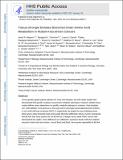Tissue of origin dictates branched-chain amino acid metabolism in mutant Kras-driven cancers
Author(s)
Ji, B. W.; Dixit, P. D.; Wolpin, B. M.; Vitkup, D.; Mayers, Jared R.; Torrence, Margaret E.; Danai, Laura V.; Papagiannakopoulos, Thales; Davidson, Shawn M.; Bauer, Matthew R.; Lau, Allison N.; Hosios, Aaron Marc; Muir, Alexander; Chin, Christopher R.; Freinkman, Elizaveta; Jacks, Tyler E.; Vander Heiden, Matthew G.; ... Show more Show less
Downloadnihms842209.pdf (1.062Mb)
OPEN_ACCESS_POLICY
Open Access Policy
Creative Commons Attribution-Noncommercial-Share Alike
Terms of use
Metadata
Show full item recordAbstract
Tumor genetics guides patient selection for many new therapies, and cell culture studies have demonstrated that specific mutations can promote metabolic phenotypes. However, whether tissue context defines cancer dependence on specific metabolic pathways is unknown. Kras activation and Trp53 deletion in the pancreas or the lung result in pancreatic ductal adenocarinoma (PDAC) or non-small cell lung carcinoma (NSCLC), respectively, but despite the same initiating events, these tumors use branched-chain amino acids (BCAAs) differently. NSCLC tumors incorporate free BCAAs into tissue protein and use BCAAs as a nitrogen source, whereas PDAC tumors have decreased BCAA uptake. These differences are reflected in expression levels of BCAA catabolic enzymes in both mice and humans. Loss of Bcat1 and Bcat2, the enzymes responsible for BCAA use, impairs NSCLC tumor formation, but these enzymes are not required for PDAC tumor formation, arguing that tissue of origin is an important determinant of how cancers satisfy their metabolic requirements.
Date issued
2016-09Department
Massachusetts Institute of Technology. Department of Biology; Koch Institute for Integrative Cancer Research at MITJournal
Science
Publisher
American Association for the Advancement of Science (AAAS)
Citation
Mayers, J. R. et al. “Tissue of Origin Dictates Branched-Chain Amino Acid Metabolism in Mutant Kras-Driven Cancers.” Science 353, 6304 (September 2016): 1161–1165 © 2016 American Association for the Advancement of Science
Version: Author's final manuscript
ISSN
0036-8075
1095-9203